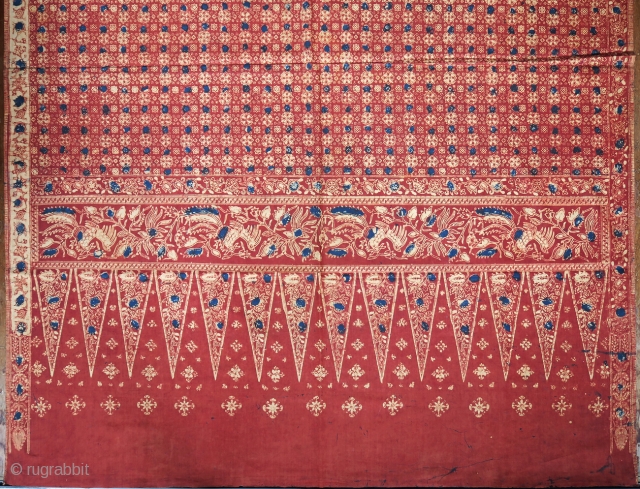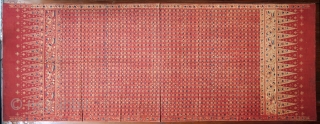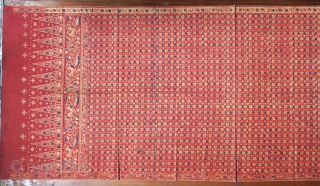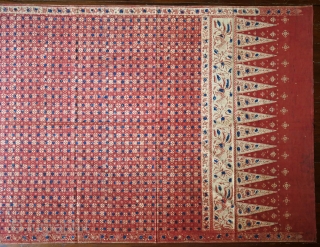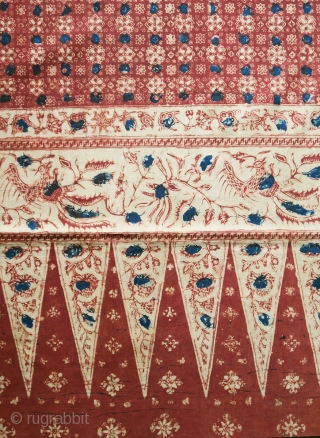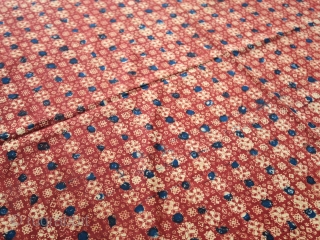Back
Sumatra | Early 20th c Batik
Hip wrapper (kain panjang)
Indonesia, Sumatra, Jambi, early 20th century
Commercial cotton, natural dyes, hand-drawn (tulis) and hand-stamped (cap) batik
A batik hipcloth most probably made in Jambi, Sumatra, with a classic Jambi design of a grid of larger and smaller rosettes in cream on an organic red ground, highlighted with dark blue spots. The decorative end sections with large triangular tumpal are in contrasting colours: cream at one end of the cloth and red at the other. This format is known as pagi-soré (“morning-evening”), a characteristic feature of Jambi hip wrappers. Similarly, one border along the long edges is cream and the other is red. The end panels at the base of the tumpal contain the Chinese bird, burong hong, amidst foliage, and are bordered by rows of banji. The piece has a rich folk character quite distinct from the emphasis on line drawing in Javanese batiks.
Context: Jambi is one of the few places in Indonesia outside Java where batik-making is practised, and its batik has a distinctive style that incorporates influences from both Sumatran textiles and batik centres along the coast of Java. The format and motifs of the centrefield have obvious similarities to the gold-threaded silk textiles from Palembang in the south, both showing the influence of prestigious Indian patola trade textiles (Djoemena, Ungkapan Sehelai Batik, 1986, 84). The burong hong and banji in the end panels localize Chinese design. Banji is the Chinese term for the Sanskrit word “swastika” (i.e. well-being”), with a similar symbolic meaning of happiness, longevity, and wealth. The colour combination of red and blue is very similar that of batik pasisir of the North Coast, from which Jambi imported much batik in this period, although the dyes used in Jambi are from different organic sources and the overall colour tone preferred in Jambi batik is darker.
The textile is in excellent condition, with no holes, stains, or tears. The colours are warm and rich, and the cotton is relatively heavy, cool to the touch and grown slightly stiff and crisp with age.
Length: 222 cm. Width: 92 cm.
Hip wrapper (kain panjang)
Indonesia, Sumatra, Jambi, early 20th century
Commercial cotton, natural dyes, hand-drawn (tulis) and hand-stamped (cap) batik
A batik hipcloth most probably made in Jambi, Sumatra, with a classic Jambi design of a grid of larger and smaller rosettes in cream on an organic red ground, highlighted with dark blue spots. The decorative end sections with large triangular tumpal are in contrasting colours: cream at one end of the cloth and red at the other. This format is known as pagi-soré (“morning-evening”), a characteristic feature of Jambi hip wrappers. Similarly, one border along the long edges is cream and the other is red. The end panels at the base of the tumpal contain the Chinese bird, burong hong, amidst foliage, and are bordered by rows of banji. The piece has a rich folk character quite distinct from the emphasis on line drawing in Javanese batiks.
Context: Jambi is one of the few places in Indonesia outside Java where batik-making is practised, and its batik has a distinctive style that incorporates influences from both Sumatran textiles and batik centres along the coast of Java. The format and motifs of the centrefield have obvious similarities to the gold-threaded silk textiles from Palembang in the south, both showing the influence of prestigious Indian patola trade textiles (Djoemena, Ungkapan Sehelai Batik, 1986, 84). The burong hong and banji in the end panels localize Chinese design. Banji is the Chinese term for the Sanskrit word “swastika” (i.e. well-being”), with a similar symbolic meaning of happiness, longevity, and wealth. The colour combination of red and blue is very similar that of batik pasisir of the North Coast, from which Jambi imported much batik in this period, although the dyes used in Jambi are from different organic sources and the overall colour tone preferred in Jambi batik is darker.
The textile is in excellent condition, with no holes, stains, or tears. The colours are warm and rich, and the cotton is relatively heavy, cool to the touch and grown slightly stiff and crisp with age.
Length: 222 cm. Width: 92 cm.
price:
USD 320
- Home
- Antique Rugs by Region
- Category
- Profiles
- Post Items Free
- Albums
- Benaki Museum of Islamic Art
- Budapest: Ottoman Carpets
- Gulbenkian Museum
- Islamic Carpets. Brooklyn
- Islamic Textiles. Brooklyn
- Konya Museum: Rugs
- MKG, Hamburg
- MMA: Caucasian Carpets
- MMA: Mamluk Carpets
- MMA: Mughal Indian Carpets
- MMA: Ottoman Carpets
- MMA: Safavid Persian Carpets
- MMA: Turkmen Rugs
- McCoy Jones Kilims
- Ottoman textiles. Met
- Philadelphia Museum
- Rugs and Carpets: Berlin
- Seljuqs at the Met
- TIEM, Istanbul: Carpets
- V&A: Classical Carpets
- Vakiflar Carpets: Istanbul
- Baluch Rugs: Indianapolis
- Gallery Exhibitions
- Jaf an Exhibition
- Alberto Levi Gallery
- Andean Textile
- Christie's London: 2016
- Francesca Galloway
- HALI at 40
- ICOC Washington, DC 2018
- Jajims of the Shahsavan
- London Islamic Week April, 2018
- Mongolian Felts
- Navajo Rugs: JB Moore
- Persian Piled Weavings
- SF Tribal & Textile Art Show 2020
- SF Tribal 2019
- Sotheby's: C. Alexander
- Turkish Prayer Rugs
- Turkmen Main Carpets ICOC 2007









